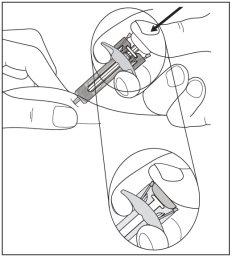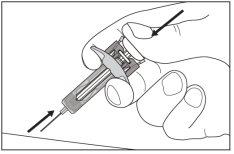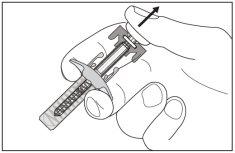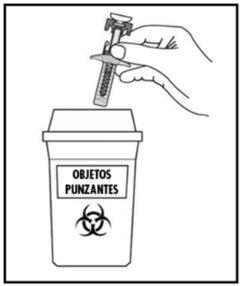
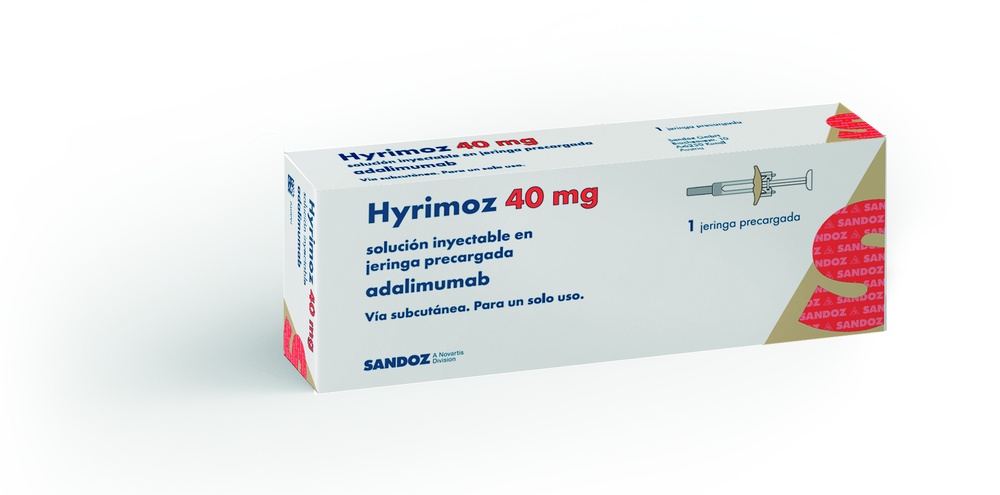
HYRIMOZ 40 mg SOLUTION FOR INJECTION IN PRE-FILLED SYRINGE


How to use HYRIMOZ 40 mg SOLUTION FOR INJECTION IN PRE-FILLED SYRINGE
Introduction
Package Leaflet: Information for the Patient
Hyrimoz 40 mg solution for injection in pre-filled syringe
adalimumab
40mg/0.8ml
Read all of this leaflet carefully before you start using this medicine because it contains important information for you.
- Keep this leaflet, you may need to read it again. Your doctor will give you a patient information card, which contains important safety information that you need to know before and during treatment with Hyrimoz. Keep this patient information card during your treatment and for 4 months after your last injection (or your child's) of Hyrimoz.
- If you have any further questions, ask your doctor or pharmacist.
- This medicine has been prescribed for you only, and you should not pass it on to others. It may harm them, even if their signs of illness are the same as yours.
- If you get any side effects, talk to your doctor or pharmacist. This includes any possible side effects not listed in this leaflet. See section 4.
Contents of the pack
- What is Hyrimoz and what is it used for
- What you need to know before you use Hyrimoz
- How to use Hyrimoz
- Possible side effects
- Storing Hyrimoz
- Contents of the pack and other information
- Instructions for use
1. What is Hyrimoz and what is it used for
Hyrimoz contains the active substance adalimumab, a medicine that works on the immune system (the body's defence system).
Hyrimoz is used to treat inflammatory diseases such as:
- rheumatoid arthritis,
- juvenile idiopathic polyarticular arthritis,
- enthesitis-related arthritis,
- ankylosing spondylitis
- axial spondyloarthritis without radiographic evidence of ankylosing spondylitis,
- psoriatic arthritis,
- psoriasis,
- hidradenitis suppurativa,
- Crohn's disease,
- ulcerative colitis and
- non-infectious uveitis.
The active substance in Hyrimoz, adalimumab, is a monoclonal antibody. Monoclonal antibodies are proteins that target a specific target in the body.
The target of adalimumab is another protein called tumour necrosis factor (TNFα), which is found in high concentrations in the inflammatory diseases described above. By binding to TNFα, Hyrimoz blocks its action and reduces inflammation in these diseases.
Rheumatoid Arthritis
Rheumatoid arthritis is an inflammatory disease of the joints.
Hyrimoz is used to treat rheumatoid arthritis in adults. If you have moderate to severe active rheumatoid arthritis, you may have been given other medicines that modify the disease, such as methotrexate, before. If these medicines have not worked well enough, you will be given Hyrimoz to treat your rheumatoid arthritis.
Hyrimoz can also be used to treat severe, active and progressive rheumatoid arthritis without prior treatment with methotrexate.
Hyrimoz can reduce the damage to the cartilage and bones of the joints caused by the disease and improve physical function.
Hyrimoz is usually used in combination with methotrexate. If your doctor considers that methotrexate is not suitable, Hyrimoz can be given alone.
Juvenile Idiopathic Polyarticular Arthritis and Enthesitis-Related Arthritis
Juvenile idiopathic polyarticular arthritis and enthesitis-related arthritis are inflammatory diseases of the joints that usually appear for the first time in childhood.
Hyrimoz is used to treat juvenile idiopathic polyarticular arthritis in children and adolescents from 2 to 17 years of age and enthesitis-related arthritis in children from 6 to 17 years of age. Patients may have been given other disease-modifying medicines, such as methotrexate, before. If these medicines have not worked well enough, patients will be given Hyrimoz to treat their juvenile idiopathic polyarticular arthritis or enthesitis-related arthritis.
Ankylosing Spondylitis and Axial Spondyloarthritis without Radiographic Evidence of Ankylosing Spondylitis
Ankylosing spondylitis and axial spondyloarthritis without radiographic evidence of ankylosing spondylitis are inflammatory diseases that affect the spine.
Hyrimoz is used in adults to treat these diseases. If you have ankylosing spondylitis or axial spondyloarthritis without radiographic evidence of ankylosing spondylitis, you will be treated first with other medicines and if these medicines do not work well enough, you will be given Hyrimoz to reduce the signs and symptoms of your disease.
Psoriasis in Adults and Children
Plaque psoriasis is an inflammatory disease of the skin that causes red, scaly, crusty, and silvery-scaled areas. Psoriasis can also affect the nails, causing them to deteriorate, thicken, and lift off the nail bed, which can be painful. It is believed that psoriasis is caused by a defect in the body's immune system that leads to an increase in the production of skin cells.
Hyrimoz is used to treat moderate to severe plaque psoriasis in adults. Hyrimoz is also used to treat severe plaque psoriasis in children and adolescents from 4 to 17 years of age who have not responded or are not suitable for topical treatments or light therapy.
Psoriatic Arthritis
Psoriatic arthritis is an inflammatory disease of the joints associated with psoriasis.
Hyrimoz is used to treat psoriatic arthritis in adults. Hyrimoz can reduce the joint damage caused by the disease in the cartilage and bone and improve physical function.
Hidradenitis Suppurativa in Adults and Adolescents
Hidradenitis suppurativa (also known as inverse acne) is a long-term and often painful inflammatory skin disease. Symptoms can include painful nodules (lumps) and abscesses (boils) that can ooze pus.
It usually affects specific areas of the skin, such as under the breast, armpits, inner thighs, groin, and buttocks. There may also be scarring in the affected areas.
Hyrimoz is used to treat hidradenitis suppurativa in adults and adolescents from 12 years of age. Hyrimoz can reduce the number of nodules and abscesses and the pain associated with this disease. You may have received other medicines before. If these medicines have not worked well enough, you will be given Hyrimoz.
Crohn's Disease in Adults and Children
Crohn's disease is an inflammatory disease of the digestive tract.
Hyrimoz is used to treat Crohn's disease in adults and children from 6 to 17 years of age. If you have Crohn's disease, you will be treated first with other medicines. If you do not respond well enough to these medicines, you will be given Hyrimoz to reduce the signs and symptoms of Crohn's disease.
Ulcerative Colitis in Adults and Children
Ulcerative colitis is an inflammatory disease of the large intestine.
Hyrimoz is used to treat moderate to severe ulcerative colitis in adults and children from 6 to 17 years of age. If you have ulcerative colitis, you may be given other medicines first. If these medicines do not work well enough, you will be given Hyrimoz to reduce the signs and symptoms of your disease.
Non-Infectious Uveitis in Adults and Children
Non-infectious uveitis is an inflammatory disease that affects certain parts of the eye. The inflammation causes a decrease in vision and/or the presence of floaters in the eye (black dots or thin lines that move along the field of vision). Hyrimoz works by reducing this inflammation.
Hyrimoz is used to treat
- adults with non-infectious uveitis with inflammation that affects the back of the eye,
children from 2 years of age with chronic non-infectious uveitis with inflammation that affects the front of the eye.
2. What you need to know before you start using Hyrimoz
Do not use Hyrimoz
- If you are allergic to adalimumab or any of the other components of this medicine (listed in section 6).
- If you have a severe infection, including tuberculosis, sepsis (blood poisoning), or other opportunistic infections (uncommon infections associated with a weakened immune system). If you have symptoms of any infection, such as fever, wounds, fatigue, or dental problems, it is essential that you inform your doctor (see "Warnings and precautions").
- If you have moderate or severe heart failure. It is essential that you tell your doctor if you have had or have any serious heart problems (see "Warnings and precautions").
Warnings and precautions
Consult your doctor or pharmacist before starting to use Hyrimoz.
Allergic reaction
- If you have an allergic reaction with symptoms such as chest tightness, difficulty breathing, dizziness, swelling, or rash, stop administering Hyrimoz and contact your doctor immediately, as these reactions can be life-threatening in rare cases.
Infection
- If you have any infection, including chronic or localized infections (e.g., a leg ulcer), consult your doctor before starting treatment with Hyrimoz. If you are unsure, contact your doctor.
- With Hyrimoz treatment, you may be more likely to get infections. This risk may be higher if you have reduced lung function. These infections can be severe and include tuberculosis, viral, fungal, parasitic, or bacterial infections, or other uncommon infectious organisms, and sepsis (blood poisoning).
- In rare cases, these infections can be life-threatening. It is essential that if you have symptoms such as fever, wounds, fatigue, or dental problems, you inform your doctor. Your doctor may recommend temporarily stopping treatment with Hyrimoz.
Tuberculosis (TB)
- Since cases of tuberculosis have been reported in patients treated with adalimumab, your doctor will examine you for signs or symptoms of tuberculosis before starting your treatment with Hyrimoz. This includes a thorough medical evaluation, including your medical history and diagnostic tests (e.g., chest X-ray and tuberculin test). The performance and results of these tests should be recorded on your patient information card. It is crucial that you inform your doctor if you have had tuberculosis or have been in contact with a tuberculosis patient. Tuberculosis can develop during treatment, even if you have received preventive treatment for tuberculosis. If symptoms of tuberculosis (persistent cough, weight loss, general malaise, low-grade fever) or any other infection appear during or after treatment, contact your doctor immediately.
Travel/infection recurrence
- Inform your doctor if you have lived or traveled in regions where fungal infections such as histoplasmosis, coccidioidomycosis, or blastomycosis are common.
- Inform your doctor if you have a history of recurrent infections or other conditions or factors that increase the risk of infections.
Hepatitis B virus
- Inform your doctor if you are a carrier of the hepatitis B virus (HBV), if you have an active HBV infection, or if you think you may be at risk of contracting HBV. Your doctor should perform an HBV test. Adalimumab may reactivate HBV in people carrying this virus. In rare cases, especially if you are taking other medications that suppress the immune system, reactivation of HBV infection can be life-threatening.
Age over 65 years
- If you are over 65 years old, you may be more susceptible to infections while being treated with Hyrimoz. Both you and your doctor should pay special attention to the appearance of signs of infection while being treated with Hyrimoz. It is essential that you inform your doctor if you have symptoms of infections, such as fever, wounds, feeling tired, or dental problems.
Dental procedures or surgery
- If you are going to have surgery or dental work, inform your doctor that you are using Hyrimoz. Your doctor may recommend that you temporarily stop treatment with Hyrimoz.
Demyelinating disease
- If you have or develop a demyelinating disease (a disease that affects the insulating layer surrounding nerves, such as multiple sclerosis), your doctor will decide whether you should be treated or continue treatment with Hyrimoz. Inform your doctor immediately if you have symptoms such as changes in vision, weakness in arms or legs, or numbness or tingling in any part of the body.
Vaccines
- Certain vaccines contain live, attenuated forms of bacteria or viruses that can cause disease and should not be administered during treatment with Hyrimoz, as they may cause infections. Consult your doctor before administering any vaccine. It is recommended that children receive all scheduled vaccinations for their age before starting treatment with Hyrimoz. If you receive Hyrimoz while pregnant, your child may have a higher risk of infection during the approximately 5 months following the last dose of Hyrimoz you received during pregnancy. It is essential that you inform your child's doctor and other healthcare professionals about your use of Hyrimoz during pregnancy, so they can decide whether your child should receive any vaccine.
Heart failure
- It is essential that you inform your doctor if you have had or have serious heart problems. If you have mild heart failure and are being treated with Hyrimoz, your doctor should closely monitor your heart failure. If new symptoms of heart failure appear or existing ones worsen (e.g., difficulty breathing or swelling of the feet), you should contact your doctor immediately.
Fever, bruising, bleeding, or pale appearance
- In some patients, the body may be unable to produce a sufficient number of the type of blood cells that fight infections (white blood cells) or those that help stop bleeding (platelets). If you have persistent fever, bruising, or bleeding easily, or are very pale, consult your doctor immediately. Your doctor may decide to interrupt treatment.
Cancer
- In very rare cases, certain types of cancer have been reported in children and adults treated with adalimumab or other TNFα blockers. People with more severe rheumatoid arthritis and those who have had the disease for a long time may have a higher-than-average risk of developing lymphoma and leukemia (cancer that affects blood cells and bone marrow). If you are being treated with Hyrimoz, the risk of lymphoma, leukemia, and other types of cancer may increase. A specific and severe type of lymphoma has been observed in patients treated with adalimumab. Some of these patients were also receiving treatment with azathioprine or mercaptopurine. Inform your doctor if you are taking azathioprine or mercaptopurine with Hyrimoz.
- Additionally, cases of non-melanoma skin cancer have been observed in patients using adalimumab. Inform your doctor if new areas of damaged skin appear or if existing damaged areas change in appearance during or after treatment.
- Cases of cancer, other than lymphoma, have been reported in patients with a specific lung disease, called chronic obstructive pulmonary disease (COPD), treated with another TNFα blocker. If you have COPD or are a heavy smoker, you should consult your doctor to determine whether treatment with a TNFα blocker is suitable for you.
Autoimmune diseases
- In rare cases, treatment with Hyrimoz may lead to a lupus-like syndrome. Contact your doctor if you have symptoms such as unexplained persistent rash, fever, joint pain, or fatigue.
Children and adolescents
- Vaccines: if possible, your child should be up to date with all vaccinations before using Hyrimoz
- Do not administer Hyrimoz to children under 2 years old with polyarticular juvenile idiopathic arthritis.
Other medicines and Hyrimoz
Inform your doctor or pharmacist if you are taking, have recently taken, or might take any other medicines.
Hyrimoz can be taken with methotrexate or with certain disease-modifying antirheumatic drugs (sulfasalazine, hydroxychloroquine, leflunomide, and injectable gold salts), corticosteroids, or pain medications, including non-steroidal anti-inflammatory drugs (NSAIDs).
Do not use Hyrimoz with medicines whose active substances are anakinra or abatacept, due to an increased risk of severe infection. It is not recommended to combine adalimumab and other TNFα blockers with anakinra or abatacept, due to the possible increased risk of infections, including severe infections, and other potential pharmacological interactions. If you have any doubts, consult your doctor.
Pregnancy and breastfeeding
- You should consider using adequate contraceptive methods to avoid becoming pregnant and continue using them for at least 5 months after the last treatment with Hyrimoz.
- If you are pregnant, think you may be pregnant, or plan to have a baby, ask your doctor for advice on using this medicine.
- Hyrimoz should be used during pregnancy only if necessary.
- According to a pregnancy study, there was no increased risk of congenital defects when the mother had received treatment with adalimumab during pregnancy compared to mothers with the same disease who did not receive treatment with adalimumab.
- Hyrimoz can be used during breastfeeding.
- If you use Hyrimoz while pregnant, your child may have a higher risk of infection.
- It is essential that you inform your child's doctor and other healthcare professionals about your use of Hyrimoz during pregnancy, so they can decide whether your child should receive any vaccine (for more information on vaccines, see the "Warnings and precautions" section).
Driving and using machines
Hyrimoz has a minor influence on the ability to drive, ride a bicycle, or use machines. You may experience dizziness and vision disturbances after using Hyrimoz.
Hyrimoz contains sodium
This medicine contains less than 1 mmol (23 mg) of sodium per 0.8 ml dose; it is essentially "sodium-free".
3. How to use Hyrimoz
Follow exactly the administration instructions of this medication as indicated by your doctor. In case of doubt, consult your doctor again.
Hyrimoz is available as a 40 mg pen and as 20 mg and 40 mg pre-filled syringes for patients to administer a complete dose of 20 mg or 40 mg.
Rheumatoid arthritis, psoriatic arthritis, ankylosing spondylitis or axial spondyloarthritis without radiographic evidence of ankylosing spondylitis | ||
Age and body weight | What quantity and how often should it be taken? | Notes |
Adults | 40 mg every other week as a single dose | In the case of rheumatoid arthritis, treatment with methotrexate is maintained during the use of Hyrimoz. If your doctor determines that methotrexate is inappropriate, Hyrimoz may be administered alone. If you have rheumatoid arthritis and do not receive methotrexate during your treatment with Hyrimoz, your doctor may decide to give you 40 mg of Hyrimoz every week or 80 mg every other week. |
Polyarticular juvenile idiopathic arthritis | ||
Age and body weight | What quantity and how often should it be taken? | Notes |
Children, adolescents, and adults from 2 years of age with a weight of 30 kg or more | 40 mg every other week | Not applicable |
Children and adolescents from 2 years of age with a weight between 10 kg and less than 30 kg | 20 mg every other week | Not applicable |
Arthritis associated with enthesitis | ||
Age and body weight | What quantity and how often should it be taken? | Notes |
Children, adolescents, and adults from 6 years of age with a weight of 30 kg or more | 40 mg every other week | Not applicable |
Children and adolescents from 6 years of age with a weight between 15 kg and less than 30 kg | 20 mg every other week | Not applicable |
Psoriasis | ||
Age and body weight | What quantity and how often should it be taken? | Notes |
Adults | An initial dose of 80 mg (as two 40 mg injections on the same day), followed by 40 mg every other week starting one week after the initial dose. | You should continue injecting Hyrimoz for as long as your doctor has indicated. If that dose does not work well enough, your doctor may increase the dose to 40 mg weekly or 80 mg every other week. |
Plaque psoriasis | ||
Age and body weight | What quantity and how often should it be taken? | Notes |
Children and adolescents from 4 to 17 years of age with a weight of 30 kg or more | An initial dose of 40 mg, followed by 40 mg one week later. Then, the usual dose is 40 mg every other week. | Not applicable |
Children and adolescents from 4 to 17 years of age with a weight between 15 kg and less than 30 kg | An initial dose of 20 mg, followed by 20 mg one week later. Then, the usual dose is 20 mg every other week. | Not applicable |
Hiddenitis suppurativa | ||
Age and body weight | What quantity and how often should it be taken? | Notes |
Adults | An initial dose of 160 mg (as four 40 mg injections on the same day or two 40 mg injections per day for two consecutive days), followed by a dose of 80 mg (as two 40 mg injections on the same day) two weeks later. After two more weeks, continue with a dose of 40 mg weekly or 80 mg every other week, as prescribed by your doctor. | It is recommended to use an antiseptic liquid daily on the affected areas. |
Adolescents from 12 to 17 years of age with a weight of 30 kg or more | An initial dose of 80 mg (as two 40 mg injections on the same day), followed by 40 mg every other week starting one week later. | If that dose does not work well enough, your doctor may increase the dose to 40 mg weekly or 80 mg every other week. It is recommended to use an antiseptic liquid daily on the affected areas. |
Crohn's disease | ||
Age and body weight | What quantity and how often should it be taken? | Notes |
Adults | An initial dose of 80 mg (as two 40 mg injections on the same day), followed by 40 mg every other week starting two weeks later. If a faster response is required, your doctor may prescribe an initial dose of 160 mg (as four 40 mg injections on the same day or two 40 mg injections per day for two consecutive days), followed by 80 mg (as two 40 mg injections on the same day) two weeks later. Then, the usual dose is 40 mg every other week. | If that dose does not work well enough, your doctor may increase the dose to 40 mg weekly or 80 mg every other week. |
Pediatric Crohn's disease | ||
Age and body weight | What quantity and how often should it be taken? | Notes |
Children and adolescents from 6 to 17 years of age with a weight of 40 kg or more | An initial dose of 80 mg (as two 40 mg injections on the same day), followed by 40 mg every other week starting two weeks later. If a faster response is required, your doctor may prescribe an initial dose of 160 mg (as four 40 mg injections on the same day or two 40 mg injections per day for two consecutive days) followed by 80 mg (as two 40 mg injections on the same day) two weeks later. Then, the usual dose is 40 mg every other week. | If that dose does not work well enough, your child's doctor may increase the dose to 40 mg weekly or 80 mg every other week. |
Children and adolescents from 6 to 17 years of age with a weight less than 40 kg | An initial dose of 40 mg followed by 20 mg every other week starting two weeks later. If a faster response is required, your doctor may prescribe an initial dose of 80 mg (as two 40 mg injections on the same day) followed by 40 mg two weeks later. Then, the usual dose is 20 mg every other week. | If that dose does not work well enough, your child's doctor may increase the frequency of the dose to 20 mg weekly. |
Ulcerative colitis | ||
Age and body weight | What quantity and how often should it be taken? | Notes |
Adults | An initial dose of 160 mg (as four 40 mg injections on the same day or two 40 mg injections per day for two consecutive days) followed by 80 mg (as two 40 mg injections on the same day) two weeks later. Then, the usual dose is 40 mg every other week. | If that dose does not work well enough, your doctor may increase the dose to 40 mg weekly or 80 mg every other week. |
Pediatric ulcerative colitis | ||
Age and body weight | What quantity and how often should it be taken? | Notes |
Children and adolescents from 6years of age with a weight of 40kg or more | An initial dose of 160 mg (as four 40 mg injections on the same day or two 40 mg injections per day for two consecutive days) initially, followed by 80 mg (as two 40 mg injections on the same day) two weeks later. Then, the usual dose is 80 mg every other week (as two 40 mg injections per day). | Patients who turn 18 years old while being treated with 80 mg every other week should continue with the prescribed dose. |
Children and adolescents from 6years of age with a weight less than 40kg | An initial dose of 80 mg (as two 40 mg injections on the same day) initially, followed by 40 mg (as one 40 mg injection) two weeks later. Then, the usual dose is 40 mg every other week. | Patients who turn 18 years old while being treated with 40 mg every other week should continue with the prescribed dose. |
Non-infectious uveitis | ||
Age and body weight | What quantity and how often should it be taken? | Notes |
Adults | An initial dose of 80 mg (as two 40 mg injections), followed by 40 mg every other week starting one week after the initial dose. | In non-infectious uveitis, treatment with corticosteroids or other medications that affect the immune system may be continued during the use of Hyrimoz. Hyrimoz may also be administered alone. You should continue injecting Hyrimoz for as long as your doctor has indicated. |
Children and adolescents from 2 years of age with a weight of 30 kg or more | 40 mg every other week along with methotrexate | Your doctor may also prescribe an initial dose of 80 mg, which may be administered one week before starting the usual dose. |
Children and adolescents from 2 years of age with a weight less than 30 kg | 20 mg every other week along with methotrexate | Your doctor may also prescribe an initial dose of 40 mg, which may be administered one week before starting the usual dose. |
Form and route of administration
Hyrimoz is injected under the skin (subcutaneously).
Detailed instructions on how to inject Hyrimoz are found in section 7, "Instructions for use".
If you use more Hyrimoz than you should
If you accidentally inject Hyrimoz more frequently than you should, call your doctor or pharmacist and explain that you have taken more than necessary. Always carry the medicine box with you, even if it is empty.
If you forget to use Hyrimoz
If you forget to administer an injection, you should inject the next dose of Hyrimoz as soon as you remember. Then, the next dose will be administered as usual, as if you had not forgotten a dose.
If you interrupt treatment with Hyrimoz
The decision to stop using Hyrimoz should be discussed with your doctor. Your symptoms may return after stopping treatment.
If you have any other questions about the use of this medication, ask your doctor or pharmacist.
4. Possible Adverse Effects
Like all medicines, this medicine can cause adverse effects, although not all people suffer from them. Most adverse effects are mild to moderate. However, some can be serious and require treatment. Adverse effects may appear up to 4 months or more after the last injection of Hyrimoz.
Seek medical attention urgentlyif you notice any of the following signs of allergic reaction or heart failure:
- severe rash, hives;
- swelling of the face, hands, feet;
- difficulty breathing, swallowing;
- difficult breathing when exercising or lying down or swelling of feet.
Contact your doctor as soon as possibleif you notice any of the following effects:
- signs and symptoms of infection such as fever, nausea, wounds, dental problems, burning sensation when urinating, feeling of weakness, fatigue or cough;
- symptoms of nervous system problems, such as tingling, numbness, double vision, weakness in arms or legs;
- signs of skin cancer, such as a lump or an open sore that does not heal;
- signs and symptoms of blood disorders such as persistent fever, bruising, bleeding and paleness.
The following adverse effects have been observed with adalimumab:
Very common(may affect more than 1 in 10 people)
- reactions at the injection site (including pain, swelling, redness or itching);
- lower respiratory tract infections (including colds, runny nose, sinusitis, pneumonia);
- headache;
- abdominal pain (stomach);
- nausea and vomiting;
- rash;
- muscle pain.
Common(may affect up to 1 in 10 people)
- severe infections (including sepsis and flu);
- intestinal infections (including gastroenteritis);
- skin infections (including cellulitis and herpes);
- ear infection;
- mouth infections (including dental infection and cold sore);
- infections of the reproductive system;
- urinary tract infections;
- fungal infections;
- joint infections;
- benign tumors;
- skin cancer;
- allergic reactions (including seasonal allergy);
- dehydration;
- mood changes (including depression);
- anxiety;
- drowsiness and difficulty sleeping;
- sensory disturbances such as tingling, pricking or numbness;
- migraine;
- symptoms of nerve root compression (including lower back pain and leg pain);
- visual disturbances;
- eye inflammation;
- eyelid inflammation and eye swelling;
- vertigo (feeling of spinning);
- feeling of rapid heartbeat;
- high blood pressure;
- flushing;
- bruises (solid swelling with clotted blood);
- cough;
- asthma;
- difficulty breathing;
- gastrointestinal bleeding;
- indigestion (indigestion, bloating and heartburn);
- acid reflux;
- dry eye syndrome (including dryness in eyes and mouth);
- itching;
- itchy rash;
- bruises;
- skin inflammation (such as eczema);
- breakage of fingernails and toenails;
- increased sweating;
- hair loss;
- new or worsening psoriasis;
- muscle spasms;
- blood in urine;
- kidney problems;
- chest pain;
- edema (fluid accumulation in the body that can cause swelling of the affected tissue);
- fever;
- low platelet count in blood, which increases the risk of bleeding or bruising;
- wound healing problems.
Uncommon(may affect up to 1 in 100 people)
- unusual infections (including tuberculosis) and other infections that occur when disease resistance decreases;
- neurological infections (including viral meningitis);
- eye infections;
- bacterial infections;
- diverticulitis (inflammation and infection of the large intestine);
- cancer, including cancer that affects the lymphatic system (lymphoma) and melanoma (a type of skin cancer);
- immune system disorders that can affect the lungs, skin and lymph nodes (the most common presentation is in the form of a disease called sarcoidosis);
- vasculitis (inflammation of blood vessels);
- tremors;
- neuropathy (nerve damage);
- stroke;
- double vision;
- hearing loss, tinnitus;
- feeling of irregular heartbeat like skips;
- heart problems that can cause difficulty breathing or swelling of ankles;
- heart attack;
- aneurysm in the wall of a major artery, inflammation and clotting in a vein, blockage of a blood vessel;
- lung diseases that can cause difficulty breathing (including inflammation);
- pulmonary embolism (blockage of a pulmonary artery);
- pleural effusion (abnormal fluid accumulation in the pleural space);
- pancreatitis that causes severe abdominal and back pain;
- difficulty swallowing;
- facial edema;
- gallbladder inflammation; gallstones;
- fatty liver (fat accumulation in liver cells);
- night sweats;
- scars;
- abnormal muscle crisis;
- systemic lupus erythematosus (an immune system disorder that includes inflammation of the skin, heart, lungs, joints and other organs);
- sleep disturbances;
- impotence;
- inflammations.
Rare(may affect up to 1 in 1,000 people)
- leukemia (cancer that affects the blood and bone marrow);
- severe allergic reaction with shock;
- multiple sclerosis;
- nervous system disorders (such as optic neuritis of the eye and Guillain-Barré syndrome, a disease that can cause muscle weakness, abnormal sensations, tingling in the arms and upper body);
- cardiac arrest;
- pulmonary fibrosis (scarring in the lung);
- intestinal perforation (hole in the intestinal wall);
- hepatitis (liver inflammation);
- reactivation of hepatitis B virus infection;
- autoimmune hepatitis (liver inflammation caused by the body's own immune system);
- cutaneous vasculitis (inflammation of blood vessels in the skin);
- Stevens-Johnson syndrome (a potentially life-threatening disease with flu-like symptoms and blistering rash);
- facial edema associated with allergic reactions;
- erythema multiforme (inflammatory rash on the skin);
- lupus-like syndrome;
- angioedema (localized skin swelling);
- lichenoid reaction on the skin (purple-red itchy rash).
Frequency not known(cannot be estimated from the available data)
- hepatosplenic T-cell lymphoma (a rare and often fatal blood cancer);
- Merkel cell carcinoma (a type of skin cancer);
- Kaposi's sarcoma, a rare cancer related to human herpesvirus 8 infection. Kaposi's sarcoma usually manifests more frequently as purple-colored skin lesions;
- liver failure;
- worsening of a disease called dermatomyositis (seen as skin rash accompanied by muscle weakness).
- weight gain (for most patients, weight gain was reduced
Some adverse effects observed in clinical studies with adalimumab do not have symptoms and can only be identified through a blood test. These include:
Very common(may affect more than 1 in 10 people)
- low white blood cell count;
- low red blood cell count;
- high lipid levels in blood;
- high liver enzymes.
Common(may affect up to 1 in 10 people)
- high white blood cell count;
- low platelet count;
- high uric acid levels in blood;
- abnormal sodium levels in blood;
- low calcium levels in blood;
- low phosphate levels in blood;
- high blood sugar;
- high lactate dehydrogenase levels in blood;
- presence of autoantibodies in blood;
- low potassium levels in blood.
Uncommon(may affect up to 1 in 100 people)
- high bilirubin levels (liver function test).
Rare(may affect up to 1 in 1,000 people)
- low counts in blood for white blood cells, red blood cells and platelets.
Reporting of adverse effects
If you experience any type of adverse effect, consult your doctor or pharmacist, even if it is a possible adverse effect that does not appear in this leaflet.
You can also report them directly through the national reporting system included in Appendix V. By reporting adverse effects, you can contribute to providing more information on the safety of this medicine.
5. Storage of Hyrimoz
Keep this medicine out of the sight and reach of children.
Do not use this medicine after the expiry date which is stated on the label/blister/box after “EXP”. The expiry date is the last day of the month indicated.
Store in a refrigerator (between 2 °C and 8 °C). Do not freeze.
Store the pre-filled syringe in the outer packaging to protect it from light.
Alternative storage:
When necessary (e.g. when traveling), you can store Hyrimoz at room temperature (up to 25 °C) for a maximum period of 21 days (make sure to protect it from light). Once the pre-filled syringe has been removed from the refrigerator to store it at room temperature, it must be used within the next 21 days or discarded, even if it is later returned to the refrigerator. You must record the date on which you removed the pre-filled syringe from the refrigerator and the date after which it must be discarded.
Medicines should not be disposed of via wastewater or household waste. Ask your pharmacist how to dispose of the packaging and any unused medicines. This will help protect the environment.
6. Container Contents and Additional Information
Composition of Hyrimoz
- The active substance is adalimumab. Each pre-filled syringe contains 40 mg of adalimumab in 0.8 ml of solution.
- The other components are: adipic acid, citric acid monohydrate, sodium chloride, mannitol (E 421), polysorbate 80 (E 433), hydrochloric acid (E 507), sodium hydroxide (E 524), and water for injections (see section 2 "Hyrimoz contains sodium").
Appearance and Container Contents of the Product
Hyrimoz 40 mg solution for injection (injection) in pre-filled syringe is supplied as 0.8 ml of solution that is clear to slightly opalescent, colorless to slightly yellowish.
Hyrimoz is supplied in a Type I glass syringe, single-use, with a stainless steel needle of 29 gauge with needle shield with wings, rubber needle cap (thermoplastic elastomer), and plastic plunger, with 0.8 ml of solution.
Packs containing 1 and 2 pre-filled syringes of Hyrimoz.
Multipack containers with 6 (3 packs of 2) pre-filled syringes of Hyrimoz.
Only certain pack sizes may be marketed.
Hyrimoz is available in pre-filled syringe and pre-filled pen.
Marketing Authorisation Holder
Sandoz GmbH
Biochemiestr. 10
6250 Kundl
Austria
Manufacturer
Sandoz GmbH Schaftenau
Biochemiestr. 10
6336 Langkampfen
Austria
Novartis Pharmaceutical Manufacturing GmbH
Biochemiestrasse 10
6336 Langkampfen
Austria
For further information about this medicinal product, please contact the local representative of the Marketing Authorisation Holder:
België/Belgique/Belgien Sandoz nv/sa Tél/Tel: +32 2 722 97 97 | Lietuva Sandoz Pharmaceuticals d.d filialas Tel: +370 5 2636 037 |
| Luxembourg/Luxemburg Sandoz nv/sa (Belgique/Belgien) Tél/Tel.: +32 2 722 97 97 |
Ceská republika Sandoz s.r.o. Tel: +420 225 775 111 | Magyarország Sandoz Hungária Kft. Tel.: +36 1 430 2890 |
Danmark/Norge/Ísland/Sverige Sandoz A/S Tlf./Sími/Tel: +45 63 95 10 00 | Malta Sandoz Pharmaceuticals d.d. Tel: +356 21222872 |
Deutschland Hexal AG Tel: +49 8024 908 0 | Nederland Sandoz B.V. Tel: +31 36 52 41 600 |
Eesti Sandoz d.d. Eesti filiaal Tel: +372 665 2400 | Österreich Sandoz GmbH Tel: +43 5338 2000 |
Ελλάδα Novartis (Hellas) A.E.B.E. Τηλ: +30 210 281 17 12 | Polska Sandoz Polska Sp. z o.o. Tel.: +48 22 209 70 00 |
España Sandoz Farmacéutica, S.A. Tel: +34 900 456 856 | Portugal Sandoz Farmacêutica Lda. Tel: +351 21 196 40 00 |
France Sandoz SAS Tél: +33 1 49 64 48 00 | România Sandoz SRL Tel: +40 21 407 51 60 |
Hrvatska Sandoz d.o.o. Tel: +385 1 23 53 111 | Slovenija Lek farmacevtska družba d.d. Tel: +386 1 580 21 11 |
Ireland Rowex Ltd. Tel: + 353 27 50077 | Slovenská republika Sandoz d.d. - organizačná zložka Tel: +421 2 48 200 600 |
Italia Sandoz S.p.A. Tel: +39 02 96541 | Suomi/Finland Sandoz A/S Puh/Tel: +358 10 6133 400 |
Κύπρος SANDOZ HELLAS ΜΟΝΟΠΡΟΣΩΠΗ Α.Ε. (Ελλάδα) Τηλ: +30 216 600 5000 | United Kingdom (Northern Ireland) Sandoz Limited Tel: +44 1276 69 8020 |
Latvija Sandoz d.d. Parstavnieciba Latvija Tel: +371 67 892 006 |
Date of Last Revision of this Prospectus
Other Sources of Information
Detailed information on this medicinal product is available on the European Medicines Agency website: http://www.ema.europa.eu.
- Instructions for Use
To help avoid possible infections and ensure correct use of the medicinal product, it is important that you follow these instructions.
Make sure you read, understand, and follow these instructions for use before injecting Hyrimoz. Your healthcare professional should have taught you how to prepare and inject Hyrimoz correctly with the pre-filled syringe before you use it for the first time. If you have any questions, consult your healthcare professional.
Your single-use Hyrimoz pre-filled syringe, with additional needle shield and wings
|
FigureA: Hyrimoz pre-filled syringe with needle shield and additional wings |
It is important that:
- Do not openthe outer carton until you are ready to use the syringe.
- Do not usethe syringe if the blister pack seals are broken, as its use may not be safe.
- Never leavethe syringe unattended in places where others may handle it.
- If you drop the syringe, do not use itif it is damaged or if it has fallen without the needle cap in place.
- Do not removethe needle cap until just before administering the injection.
- Be careful not to touchthe needle shield wings before using the syringe. Touching them may cause the shield to activate too early. Do not removethe wings before injection.
- To make the injection more comfortable, inject Hyrimoz 15–30 minutes after taking it out of the refrigerator.
- Discard the used syringe immediately after use. Do not reuse syringes.See “4. Disposal of Used Syringes”at the end of these instructions for use.
Storage of the Syringe
- Store the outer carton of syringes in a refrigerator, between 2 °C and 8 °C.
- When necessary (e.g., when traveling), you can store Hyrimoz at room temperature (up to 25 °C) for a maximum of 21 days (make sure to protect it from light). Once removed from the refrigerator to store at room temperature, the pre-filled syringe must be used within 21 days or discarded, even if it is later returned to the refrigerator. You must record the date you removed the pre-filled syringe from the refrigerator and the date after which it must be discarded.
- Keep the syringes in their original packaging until you are ready to use them to protect them from light.
- Do not expose the syringes to extreme heat or cold.
- Do not freeze the syringes.
Keep Hyrimoz and all medicines out of the reach of children.
What is needed for the injection?
Place the following items on a clean, flat surface.
The box includes:
- Hyrimoz pre-filled syringe(s) (see FigureA). Each syringe contains 40 mg/0.8 ml of Hyrimoz.
The box does not include (see Figure B):
- Alcohol swab
- Cotton or gauze
- Sharps disposal container
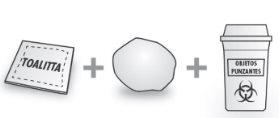
Figure B: items not included in the box
See “4. Disposal of Used Syringes”at the end of these instructions for use.
Before the Injection
|
|
FigureC: the needle shield is not activated; the syringe is ready for use | FigureD: the needle shield is activated; do not use |
|
|
Preparing the Syringe
- To make the injection more comfortable, remove the blister pack containing the syringe from the refrigerator and let it sit at room temperature for 15-30 minutes before use.
- Remove the syringe from the blister pack.
- Look through the viewing window. The solution should be clear to slightly opalescent, colorless to slightly yellowish. Do not useit if you see particles or color changes. If you are concerned about the appearance of the solution, consult your pharmacist.
- Do not use the syringe if it is broken or if the needle shield is activated. Return the syringe and its container to the pharmacy.
- Check the expiration date (EXP) on the syringe. Do not use the syringe after the expiration date.
If the syringe does not pass any of the above checks, contact your pharmacist.
- Choosing the Injection Site:
|
|
- Cleaning the Injection Site:
|
Figure F: clean the injection site |
- Administering the Injection:
|
|
Figure G: remove the needle capfrom the syringe | |
| Figure H: |
|
|
Figure I: hold the syringe | |
|
|
Figure J: pull the needle out straight | |
|
|
Figure K: release the plunger slowly |
- Disposal of Used Syringes:
|
|
If you have any questions, consult a doctor, pharmacist, or nurse who is familiar with Hyrimoz.
- Country of registration
- Active substance
- Prescription requiredYes
- Manufacturer
- CompositionCLORURO DE SODIO (4,93 mg mg), MANITOL (E-421) (9,6 mg mg), POLISORBATO 80 (0,8 mg mg), HIDROXIDO DE SODIO (E 524) (C.S ml mg)
- This information is for reference only and does not constitute medical advice. Always consult a licensed doctor before taking any medication. Oladoctor is not responsible for medical decisions based on this content.
- Alternatives to HYRIMOZ 40 mg SOLUTION FOR INJECTION IN PRE-FILLED SYRINGEDosage form: INJECTABLE, 20 mgActive substance: adalimumabManufacturer: Amgen Europe B.V.Prescription requiredDosage form: INJECTABLE, 20 mgActive substance: adalimumabManufacturer: Amgen Europe B.V.Prescription requiredDosage form: INJECTABLE, 40 mgActive substance: adalimumabManufacturer: Amgen Europe B.V.Prescription required



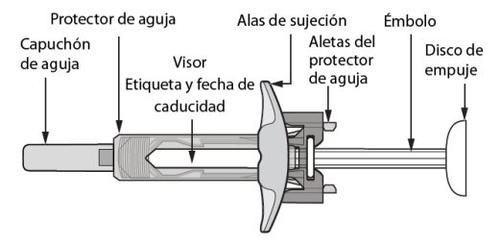


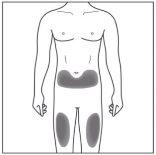 Figure E: choose the injection site
Figure E: choose the injection site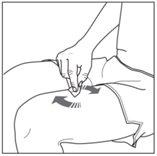
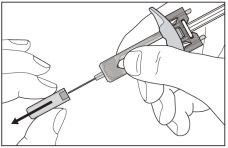
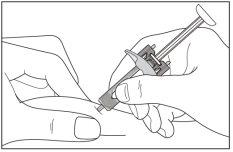 insert the needle
insert the needle